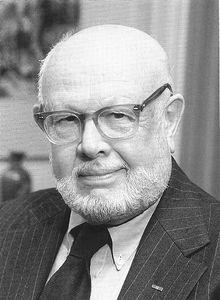William Alfred Fowler facts for kids
Quick facts for kids
William Alfred Fowler
|
|
|---|---|
 |
|
| Born | August 9, 1911 |
| Died | March 14, 1995 (aged 83) |
| Other names | Willy Fowler |
| Alma mater | Caltech (PhD) |
| Awards | Barnard Medal for Meritorious Service to Science (1965) Tom W. Bonner Prize in Nuclear Physics (1970) Vetlesen Prize (1973) National Medal of Science (1974) Eddington Medal (1978) Nobel Prize in Physics (1983) |
| Scientific career | |
| Doctoral advisor | Charles Christian Lauritsen |
| Doctoral students | J. Richard Bond, Donald Clayton, F. Curtis Michel |
William Alfred Fowler (born August 9, 1911 – died March 14, 1995) was an American scientist. He first studied nuclear physics and later became an astrophysicist. He won the Nobel Prize in Physics in 1983 with Subrahmanyan Chandrasekhar. Fowler was famous for his studies on how stars create energy and different chemical elements. He also helped write an important paper called the B2FH paper.
Contents
Early Life and Interests
William Alfred Fowler was born on August 9, 1911, in Pittsburgh, Pennsylvania. His parents were John MacLeod Fowler and Jennie Summers Watson. William was the oldest of three children.
When he was two years old, his family moved to Lima, Ohio. This town was known for its steam railroads. Growing up near the railway yard made Fowler very interested in trains.
Later in 1973, he even traveled to the USSR. He wanted to see the steam engine that powered the Trans-Siberian Railway. This train traveled nearly 2,500 kilometers connecting Khabarovsk and Moscow.
Education Journey
In 1933, Fowler graduated from Ohio State University. He was a member of the Tau Kappa Epsilon fraternity there.
He then went on to the California Institute of Technology (Caltech) in Pasadena, California. In 1936, he earned his Ph.D. in nuclear physics from Caltech.
Career in Science
After getting his Ph.D., Fowler became a research fellow at Caltech in 1936. By 1939, he was an assistant professor. He became an associate professor in 1942 and a full professor in 1946.
Even though he started as an experimental nuclear physicist, one of his most famous works was a paper. It was called "Synthesis of the Elements in Stars". He wrote it with Fred Hoyle and two young astronomers, E. Margaret Burbidge and Geoffrey Burbidge. This paper, published in 1957, explained how most chemical elements (except the very lightest ones) are made inside stars. It is widely known as the B2FH paper.
Fowler took over from Charles Lauritsen as the director of the Kellogg Radiation Laboratory at Caltech. Later, Steven E. Koonin took over from Fowler. President Gerald Ford honored Fowler with the National Medal of Science.
Awards and Recognition
William Fowler received many important awards for his work.
- In 1963, he won the Henry Norris Russell Lectureship.
- He received the Vetlesen Prize in 1973.
- The Eddington Medal was awarded to him in 1978.
- In 1979, he won the Bruce Medal.
- In 1983, he shared the Nobel Prize in Physics with Subrahmanyan Chandrasekhar. They won for their studies on how nuclear reactions inside stars create the chemical elements in the universe.
One of Fowler's students at Caltech was Donald D. Clayton.
Personal Life
Fowler loved steam locomotives throughout his life. He even owned several working models of different sizes.
His first wife was Adriane Fay (née Olmsted) Fowler. They were married until her death in 1988. They had two daughters named Mary Emily and Martha.
In December 1989, Fowler married Mary Dutcher, an artist, in Pasadena, California.
William Alfred Fowler passed away on March 14, 1995, in Pasadena, California. He was 83 years old.
See also
 In Spanish: William Alfred Fowler para niños
In Spanish: William Alfred Fowler para niños

